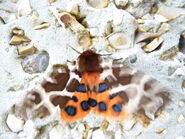
Garden Tiger ~ http://www.flickr.com/photos/qwertyqwertyqwerty/
The Garden Tiger (Arctia caja) is a moth of the Arctiidae family.
It has a wingspan of 45 to 65 millimetres (1.8 to 2.6 in). The design of the wings varies: the front wings are brown with a white pattern (which can however be missing), the hindwings orange with a pattern of black dots. The conspicuous patterns serve as a warning to predators, because the moth's body fluids are poisonous. Its effects are not yet fully known, but they contain quantities of choline esters which are neurotoxic by interfering with the acetylcholine receptor. The colours are also ideal for frightening predators such as small birds: the moth normally hides its hindwings under the cryptic forewings when resting (see photo). If a threat is perceived, the moth quickly shows its orange hindwings and flies away. In this way, it successfully confuses and warns off the predator. If a bat tries to hunt this species, the moth will send out a respond to the echo-location from the bat, as if there is no prey here, thereforth protecting this species from being hunted by bats.
Distribution[]
The garden tiger moth is found throughout Europe as far north as Lapland, in Asia, and in North America. In the mountains this species is found up to an elevation of 2,000 metres (6,600 ft). The garden tiger loves damp places, which is why it is particularly common in river valleys as well as gardens and parks. The moth is nocturnal and can usually only be seen flying around a source of light. The distinctively coloured, long-haired caterpillar, on the other hand, is seen more frequently. It can grow up to 6 cm (2.4 in) long and plays dead when in danger. These moths are most common in June to August, in gardens, park, meadows, grasslands, and scrubby areas.
On August 28, 2007, the new Biodiversity Action Plan (BAP) (launched in 1997) identified 1,149 species and 65 habitats in the UK that need conservation and greater protection. The updated list include hedgehog, house sparrows, grass snake and the garden tiger moth; otters, bottlenose dolphins and red squirrels remained in need of habitat protection.
Its numbers in the UK have declined by 89% over the past 30 years. A generation ago the 'woolly bear' caterpillar was a common sight in gardens but it is now bordering on rare in large areas of southern England. It is suspected this is due to climate change, as Garden Tigers are still common futher north.
Development[]
Eggs are laid starting in July. Large bluish-white clutches of eggs are laid on the lower surfaces of leaves. The caterpillars hatch in August. They spend the winter on the ground in protected places and pupate from June to July of the following year. The moths hatch from July to August.
The caterpillar of the garden tiger moth feeds on various kinds of non-woody plants, as well as bushes and trees. It is especially fond of raspberry, blackberry, viburnum, honeysuckle, erica, and broom.




